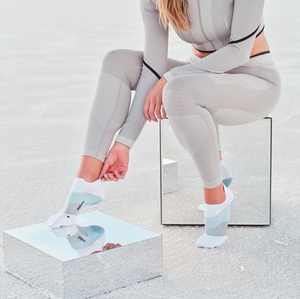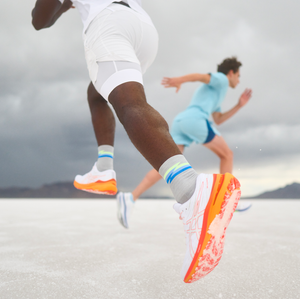Do you end the day with heavy legs or swollen ankles? Are leg cramps interrupting your sleep? It could be due to varicose veins, a rarely discussed but surprisingly pervasive condition throughout the United States. For many, this is merely a cosmetic concern, but for others it can be a painful part of daily life. Luckily, the recommended treatment is one of Feetures’ specialties. In this blog, we’ll dive into how a not-so-humble compression sock can fight back against varicose veins.
What Are Varicose Veins?
Sometimes referred to as spider veins, varicose veins occur when the valves in your veins become damaged and blood collects behind them rather than flowing back to the heart. The result is twisted, enlarged veins near the surface of the skin. Since gravity is the enemy here, varicose veins are most common in the legs and feet since blood has further to travel to the heart.
Side Effects
One of the biggest side effects of varicose veins is that they can become visible underneath your skin, showing up as blue or purple rope-like cords. While that’s not exactly fun, they often aren’t accompanied by any discomfort. That’s reserved for more severe cases that speak to a larger circulatory problem. Symptoms include:
- Swollen ankles
- Heavy or aching legs
- Fatigue and pain
- Bulging veins
- Restless legs
- Itchy skin
- Night cramps
The Benefits of Compression Socks
While compression socks for women and men can’t cure or reverse varicose veins, they can provide significant relief from these uncomfortable side effects. They can be of particular help in situations that aggravate the poor circulation behind varicose veins, such as prolonged standing or sitting, pregnancy, or long-haul travel.
As a result, compression socks have become a mainstay in treating vein problems. Initially created as a medical garment, compression socks provide gentle pressure to the legs and ankles. It’s this pressure that helps arteries relax, lets vein valves function properly, and allows blood to flow more freely back to the heart.
How To Use Compression Socks for Varicose Veins
You’ve probably noticed that your legs feel fine in the morning and swell as the day goes on. That’s because sleeping horizontally helps your vein valves function more effectively. Moving into a vertical position is when gravity rears its ugly head and blood flow slows.
With that in mind, doctors recommend putting on compression socks in the morning before you get out of bed. This will help the valves stay in the right position to circulate blood properly during the day.
What Type Do I Need?
Compression is measured in units called mmHg (millimeters of mercury). There are varying degrees of compression ranging from low to medical-grade compression. You should always talk to your doctor to get advice about the right level of compression for your condition.
Your doctor can also suggest what strength of compression would best suit your needs and health concerns. For reference, here are the general measurement guidelines:
- Mild: 15 to 20 mmHg; used for mild leg pains, varicose, and spider veins.
- Moderate: 20 to 30 mmHg; used for leg fatigue, advanced varicose veins, and moderate spider veins.
- Firm: 30 to 40 mmHg; used to prevent post-thrombotic syndrome, post sclerotherapy, and severe varicose veins.
Feetures’ High Knee Compression Socks are a good place to start for people with mild or moderate varicose veins. These socks are fully graduated, meaning they start out with a greater amount of compression at the ankle and gradually get looser up the calf. This strategic knit helps promote blood flow and circulation, relieving painful symptoms and allowing vein valves to operate better.
If you’re looking for relief, take advantage of our lifetime guarantee and try a pair of compression socks for yourself risk-free!



Leave a comment